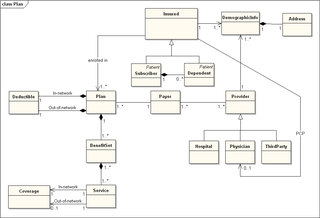Domain model
This article needs additional citations for verification. (November 2015) |

In
Overview
In the field of
The conceptual model attempts to clarify the meaning of various, usually ambiguous terms, and ensure that confusion caused by different interpretations of the terms and concepts cannot occur. Such differing interpretations could easily cause confusion amongst stakeholders, especially those responsible for designing and implementing a solution, where the conceptual model provides a key artifact of business understanding and clarity. Once the domain concepts have been modeled, the model becomes a stable basis for subsequent development of applications in the domain. The concepts of the conceptual model can be mapped into physical design or implementation constructs using either manual or
A conceptual model can be described using various notations, such as
This is often used for defining different processes in a particular company or institute.
A domain model is a system of abstractions that describes selected aspects of a sphere of knowledge, influence or activity (a domain[3]). The model can then be used to solve problems related to that domain. The domain model is a representation of meaningful real-world concepts pertinent to the domain that need to be modeled in software. The concepts include the data involved in the business and rules the business uses in relation to that data. A domain model leverages natural language of the domain.
A domain model generally uses the vocabulary of the domain, thus allowing a representation of the model to be communicated to non-technical stakeholders. It should not refer to any technical implementations such as databases or software components that are being designed.
Usage
A domain model is generally implemented as an object model within a layer that uses a lower-level layer for persistence and "publishes" an API to a higher-level layer to gain access to the data and behavior of the model.
In the Unified Modeling Language (UML), a class diagram is used to represent the domain model.
See also
- Domain-driven design (DDD)
- Domain layer
- Information model
- Feature-driven development
- Logical data model
- Mental model
- OntoUML
References
- ^ Fowler, Martin. Patterns of Enterprise Application Architecture. Addison Wesley, 2003, p. 116.
- ^ Fowler, Martin. "P of EAA - Domain Model"
- ^ Evans, Eric Domain-Driven Design: Definitions and Pattern Summaries. Domain Language Inc., 2006, p. 3.
Further reading
- ISBN 978-0-12-373568-3.
- ISBN 0-201-89542-0.
- Stewart Robinson, Roger Brooks, Kathy Kotiadis, and Durk-Jouke Van Der Zee (Eds.): Conceptual Modeling for Discrete-Event Simulation, 2010. ISBN 978-1-4398-1037-8
- David W. Embley, Bernhard Thalheim (Eds.): Handbook of Conceptual Modeling, 2011. ISBN 978-3-642-15864-3.
